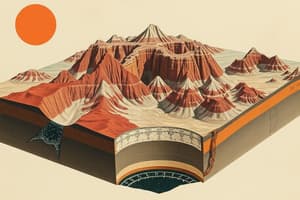Podcast
Questions and Answers
What geological process leads to the formation and growth of mountains?
What geological process leads to the formation and growth of mountains?
- Plate convergence (correct)
- Plate divergence
- Mid-ocean ridges
- Subduction
Which mountain range is cited as a prime example of mountain growth through plate convergence?
Which mountain range is cited as a prime example of mountain growth through plate convergence?
- Appalachian
- Himalayas (correct)
- Rockies
- Andes
What is the main geological process occurring at mid-ocean ridges?
What is the main geological process occurring at mid-ocean ridges?
- Subduction
- Mountain building
- New crust formation (correct)
- Plate convergence
What episode has seen the ongoing formation of some of the world's most iconic mountain ranges?
What episode has seen the ongoing formation of some of the world's most iconic mountain ranges?
Which geological process is often marked by earthquake faults such as the San Andreas Fault in California?
Which geological process is often marked by earthquake faults such as the San Andreas Fault in California?
What are tectonic plates made of?
What are tectonic plates made of?
How many main tectonic plates are there?
How many main tectonic plates are there?
What gives rise to varied geological features on Earth?
What gives rise to varied geological features on Earth?
What type of boundaries are formed when two tectonic plates move towards each other?
What type of boundaries are formed when two tectonic plates move towards each other?
What causes the movement of tectonic plates?
What causes the movement of tectonic plates?
Flashcards are hidden until you start studying
Study Notes
Unraveling the Mystery of Plate Tectonics: A Journey Through Tectonic Plates, Boundaries, and Mountain Growth
Plate tectonics, a concept that has captivated the geological community since its inception in the 1960s, offers a fascinating insight into the Earth's interior dynamics. In this article, we will delve into the intriguing world of tectonic plates, their boundaries, and the impact they have on mountain growth.
Tectonic Plates: The Foundation
The Earth's crust is not a solid, uniform shell, but rather a collection of interconnected, rigid slabs known as tectonic plates. These plates, each consisting of the Earth's crust and uppermost mantle, move in response to convection currents within the mantle. Over millions of years, these plates shift and collide with one another, forming a complex mosaic that underpins the Earth's surface.
There are seven main tectonic plates:
- African plate
- Antarctic plate
- Eurasian plate
- Indo-Australian plate
- North American plate
- Pacific plate
- South American plate
These plates interact along their boundaries, giving rise to the varied geological features we observe on Earth.
Plate Boundaries: The Interactions of Tectonic Plates
Tectonic plates interact along three distinct types of boundaries:
-
Convergent boundaries – When two plates move towards each other, they can collide, subduct one beneath the other, or create new crust through volcanic activity. Examples include the collision of the Indian and Eurasian plates, which resulted in the emergence of the Himalayan mountain range.
-
Divergent boundaries – When two plates move away from each other, new crust forms in the gap between them. This process is most evident at mid-ocean ridges, where new oceanic crust forms as the plates separate.
-
Transform boundaries – When two plates slide past each other horizontally, their boundaries tend to move in a straight line. Transform boundaries are often marked by earthquake faults, such as the San Andreas Fault in California, where the Pacific and North American plates interact.
Mountain Growth: The Impact of Plate Tectonics
The processes that occur at plate boundaries often lead to the formation and growth of mountains. For example, during a convergent boundary, the collision of two plates can result in the uplift of land. This uplift can be caused by the force of the collision, the subduction of one plate beneath the other, or the addition of new crust forming at the boundary.
The Himalayan mountain range in Asia is a prime example of mountain growth through plate convergence. The collision of the Indian and Eurasian plates has resulted in the uplift of land and the formation of the world's highest mountain range, including Mount Everest.
Mesozoic and Cenozoic Mountain-Building Episodes
Mountain growth is not a recent phenomenon. The Earth has experienced several mountain-building episodes over the course of its history:
-
Mesozoic mountain-building episode (250 to 66 million years ago) – During this time, the supercontinent Pangaea began to break apart, and the formation of the Appalachian and Barberton Greenstone belts occurred.
-
Cenozoic mountain-building episode (66 million years ago to present) – This ongoing episode has seen the formation of some of the world's most iconic mountain ranges, including the Himalayas, the Andes, and the Rockies.
Conclusion
The geological processes that underpin plate tectonics are incredible in their scope and complexity. Plate boundaries interact in ways that can result in new crust formation, the uplift of land, and the formation of mountains. This fascinating subject has captivated scientists for decades, and its mysteries continue to unfold as new research sheds light on the Earth's dynamic interior. From the collision of the Indo-Australian and Eurasian plates to create the Himalayan mountain range to the ongoing formation of the Rockies, plate tectonics continues to shape the face of our planet.
Studying That Suits You
Use AI to generate personalized quizzes and flashcards to suit your learning preferences.




